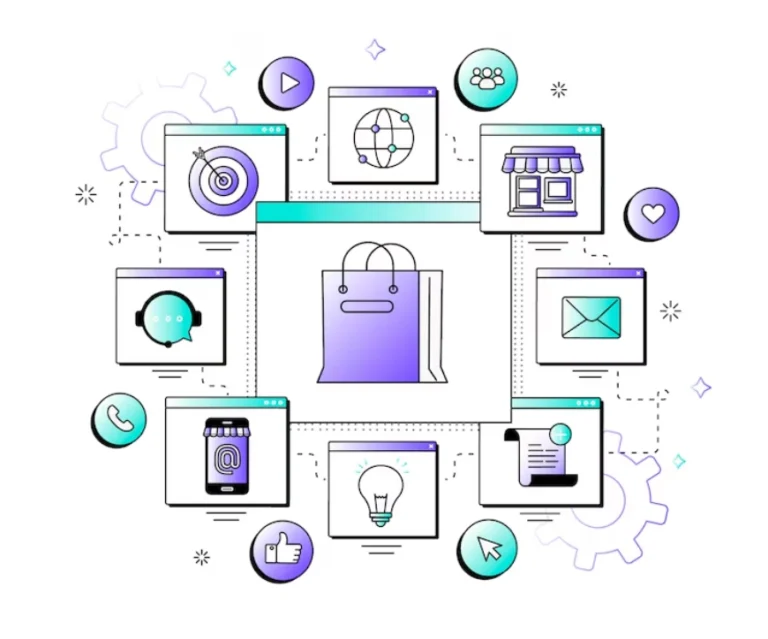According to a recent survey, a staggering 75% of online shoppers have admitted to abandoning their carts due to an outdated website experience. So you can’t afford to be complacent with outdated technology. Rather than going with rigid traditional eCommerce platforms, you can opt for composable eCommerce.
This revolutionary approach entails a modular architecture. So you can handpick best-of-breed solutions for each aspect of their online operations, from product information management and checkout systems to CRM and marketing automation. That will allow for unparalleled customization and personalization.
Through this blog, we’ll dive deep into the concept of composable architecture and explain how the eCommerce experts go about the implementation and its benefits. Let’s begin.
What is Composable eCommerce?
Composable commerce is an approach to building eCommerce websites that emphasizes flexibility and customization by using modular components. A monolithic platform tries to do everything. Instead, with composable eCommerce, you can choose the best-of-breed solutions for each specific need and “compose” them together to create a customized system.
For this architecture, you can select individual components like:
- Product Information Management (PIM): To manage product data.
- Checkout systems: To handle payments and orders.
- Content Management System (CMS): To manage website content.
- Customer Relationship Management (CRM): To manage customer interactions.
These components are connected via APIs (Application Programming Interfaces), allowing them to communicate and work together seamlessly.
Let’s look at the components in detail.
Key Components of a Composable eCommerce Architecture
Composable eCommerce involves breaking down the traditional monolithic eCommerce platforms into smaller, independent components or services. These components can be combined and customized to create tailored eCommerce experiences.
Headless Commerce Platform
A headless commerce platform is the foundation of a composable architecture. It separates the front-end presentation layer from the back-end commerce logic. This decoupling allows for greater flexibility and customization, enabling businesses to deliver consistent brand experiences across multiple channels.
Product Information Management (PIM)
PIM systems centralize and manage product information, ensuring consistency and accuracy across all sales channels. This includes product attributes, descriptions, images, and pricing. By streamlining product data, PIM helps businesses improve time-to-market and enhance customer experience.
Digital Asset Management (DAM)
DAM systems store and manage digital assets, such as images, videos, and documents. They provide efficient organization, search capabilities, and version control for these assets. DAM helps businesses maintain brand consistency and deliver high-quality digital experiences.
Content Management System (CMS)
A CMS empowers businesses to create, manage, and publish digital content. It enables the creation of engaging product descriptions, blog posts, and marketing materials. By simplifying content creation and management, CMS helps businesses improve SEO and drive customer engagement.
Customer Relationship Management (CRM)
CRM systems help businesses manage customer interactions and data. They provide insights into customer behavior, preferences, and purchase history. By leveraging CRM, businesses can personalize marketing campaigns, improve customer service, and foster long-term relationships.
Payment & Fraud Prevention
A robust payment and fraud prevention solution is essential for secure and efficient online transactions. It includes features like tokenization, encryption, and fraud detection algorithms. By implementing these measures, businesses can protect customer data and prevent fraudulent activities.
Order Management System (OMS)
An Order Management System streamlines the order fulfillment process, from order placement to shipment. It automates tasks like inventory management, order routing, and shipping label generation. By optimizing order fulfillment, OMS helps businesses improve delivery times and reduce operational costs.
If you need help with integrating these components to create the best composable eCommerce, get our professional eCommerce development services.
We’ll help you choose the best solutions and proceed with the suitable integration method for the best results. To better understand how all the parts come together, explore the fundamentals of eCommerce architecture and how it supports scalability, performance, and flexibility in modern online stores.
Best Ways to Set Up Composable eCommerce
Integrating composable eCommerce requires a strategic approach and careful consideration of various factors. To that end, there are a few methods to consider:
API-first Approach
An API-first approach prioritizes the design and development of APIs. That facilitates seamless communication between different components of a composable eCommerce system. By defining clear and consistent APIs, businesses can easily integrate new features and functionalities. That accelerates time-to-market and improves overall system agility.
Microservices Architecture
A microservices architecture breaks down a large, monolithic application into smaller, independent services. This modular approach enables businesses to develop, deploy, and scale individual services independently, improving flexibility, scalability, and resilience.
Cloud-native Technologies
Cloud-native technologies, such as containers and serverless computing, are essential for building and deploying composable eCommerce systems. These technologies enable businesses to leverage the scalability, reliability, and cost-effectiveness of cloud platforms to deliver exceptional customer experiences.
Headless Commerce
Headless commerce separates the front-end presentation layer from the back-end commerce logic. This decoupled architecture allows businesses to deliver consistent brand experiences across multiple channels, including web, mobile, and IoT devices.
By integrating a headless commerce platform with other composable components, businesses can create highly personalized and engaging customer experiences.
As you may understand, these integrations can be a little tricky for those without the technical know-how. So hiring our dedicated eCommerce developers would be a better decision.
But of course, you need to understand the challenges with composable eCommerce before proceeding.
Challenges With Composable eCommerce
While composable eCommerce offers numerous benefits, it also presents several challenges that businesses should consider:
Increased Complexity
Managing multiple interconnected systems can be complex and requires specialized technical expertise. Ensuring seamless integration and data consistency across different components can be challenging.
Higher Initial Investment
Implementing a composable architecture often involves significant upfront costs, including the purchase of multiple technologies and the hiring of skilled IT professionals.
Vendor Lock-in
Relying on multiple vendors for different components can lead to vendor lock-in, making it difficult to switch to alternative solutions. Ensuring compatibility and seamless integration between different vendor solutions can be challenging.
Security Risks
A composable architecture exposes multiple systems and APIs to potential security threats. Strong security measures must be implemented to protect sensitive customer data and prevent cyberattacks.
Skill Gap
Finding and hiring skilled professionals with expertise in composable architecture, API development, and microservices can be difficult. Organizations may need to invest in training and development to upskill their existing workforce.
But let’s say you take care of these challenges. Then what kind of benefits do you stand to get?
Benefits of Composable eCommerce
Composable eCommerce offers a flexible and scalable approach to building and managing online stores, providing numerous benefits for businesses:
- Rapid Adaptation to Market Changes: Businesses can quickly adapt to changing market trends and customer preferences by easily swapping out or adding new components.
- Personalized Customer Experiences: By combining different components, businesses can create highly personalized shopping experiences tailored to individual customer needs and preferences.
- Scalable Infrastructure: Composable architecture allows businesses to scale their infrastructure up or down to meet fluctuating demand, ensuring optimal performance during peak traffic periods.
- Future-Proof Technology Stack: By leveraging modern technologies like microservices and cloud-native solutions, businesses can future-proof their eCommerce platform.
- Seamless Omnichannel Experiences: Composable eCommerce enables consistent and seamless customer experiences across multiple channels, including web, mobile, and social media.
- Faster Load Times and Improved Performance: By optimizing individual components, businesses can significantly improve website performance and reduce page load times.
- Reduced Development and Maintenance Costs: By leveraging pre-built components and APIs, businesses can reduce development and maintenance costs.
- Optimized Resource Utilization: Composable architecture allows businesses to optimize resource utilization, reducing infrastructure costs.
- Faster Innovation: By breaking down complex systems into smaller, independent components, businesses can accelerate the development and deployment of new features and functionalities.
- Rapid Response to Market Opportunities: Businesses can quickly capitalize on emerging market opportunities by rapidly launching new products or services.
If you need help with ensuring the best of these benefits for your eStore, get our eCommerce consulting services. We’ll help you choose the best integrations and approach for outstanding results.
Let’s Summarize
Composable eCommerce breaks down monolithic platforms into smaller, independent components. That helps you achieve unprecedented levels of flexibility, scalability, and personalization. For that, you can adopt an API-first approach, leverage microservices architecture, and even opt for cloud-native technologies.
But while there are some long-term benefits, there are also certain challenges with the implementation, like increased complexity and higher initial investment.
So if you want the best results, connect with our experts today!
FAQs on Composable eCommerce
Q1. How Does Composable eCommerce Differ from Traditional eCommerce?
Traditional eCommerce platforms are monolithic, meaning all components are tightly integrated. Composable eCommerce, on the other hand, is modular, allowing for greater flexibility and customization.
Q2. Is composable eCommerce suitable for small businesses?
While composable eCommerce can be a powerful tool for businesses of all sizes, it may be more suitable for larger enterprises with complex business requirements. However, as technology continues to evolve, composable solutions are becoming more accessible and affordable for smaller businesses.
Q3. What role does microservices architecture play in Composable eCommerce?
A microservices architecture breaks down a large, monolithic application into smaller, independent services. This modular approach enables businesses to develop, deploy, and scale individual services independently, improving flexibility, scalability, and resilience.





